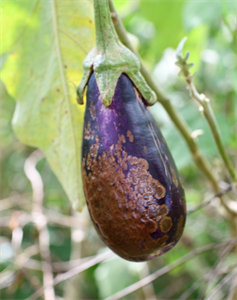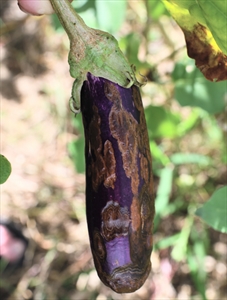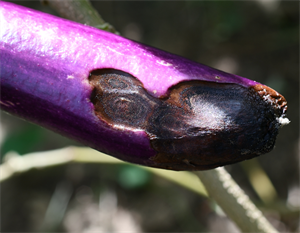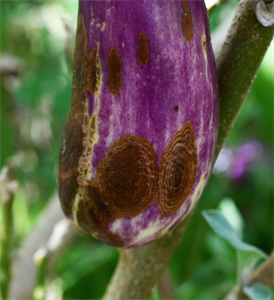Eggplant anthracnose, eggplant fruit rot
Pacific Pests, Pathogens and Weeds - Online edition
Pacific Pests, Pathogens & Weeds
Eggplant anthracnose (390)
Colletotrichum species, particularly, Colletotrichum capsici, and Colletotrichum gloeosporioides. The sexual state is Glomerella cingulata (see Fact Sheet no. 177).
Colletotrichum capsici: Asia, Africa, North America, Europe, Oceania. It is recorded from Cook Islands, Fiji, French Polynesia, Guam, New Caledonia, Niue, Palau, Papua New Guinea, Samoa, Solomon Islands, Tonga, Vanuatu, and Wallis & Futuna.
Colletotrichum gloeosporioides: Worldwide. It is recorded from Australia, American Samoa, Cook Islands, Federated States of Micronesia, Fiji, Guam, Kiribati, Marshall Islands, New Caledonia, Niue, Palau, Papua New Guinea, Samoa, Solomon Islands, Tonga, Tuvalu, and Vanuatu.
Wide host range. McKenzie (2012)1 states: "Colletotrichum capsici has been ... associated with fruit rots, stem die back, and on flowers and leaves causing blossom blight, leaf spots, etc. It is one of the main causes of chilli anthracnose, but it is not the only one. Depending on the chilli variety, Colletotrichum acutatum, Colletotrichum capsici and Colletotrichum gloeosporioides were all isolated from Thailand". They were also all isolated from chilli in Fiji (see Fact Sheet no. 177).
On fruits of eggplant, the first signs of this fungal disease are small, light-brown irregular-shaped spots (Photo 1). Multiple infections are common. The spots darken, expand along the length of the fruit, and merge forming large brown slightly raised warty patches, especially at the base of the fruits (Photos 2&3). Single spots tend to be sunken (Photos 3&4), but whether single or merged they show light and dark-brown target-like rings more clearly seen at the margins of spots and patches (Photo 5).
As the spots as and become sunken, tiny, black fruiting bodies form in the spots.
As with similar infections on capsicum and chilli (see Fact Sheet no. 177), infection occurs at any stage of fruit development, but symptoms usually appear on the fruit when they are about to ripen. Warm wet weather, with temperatures around 27°C, and humidity above 80%, are also likely to be ideal for disease development, with fruit wetness a particularly important factor as it is with capsicum and chilli anthracnose diseases.
Spread of the fungi over short distances is by spores in wind-driven rain, and probably on insects and tools. Survival between crops is in debris in the soil and on or in seed. Seed is also a method of long-distance spread. It is likely that survival also occurs on other crops and weeds; these fungi have a wide host range.
This is a serious disease; in Fiji, losses are estimated to be 10-25% of the crop.
Look for the characteristic brown scabby rots on the fruit, often largest at the furthest end of the fruit. Look for the distinct light and dark brown rings at the margins of individual spots, and sometimes on the patches. Look for the black fruiting bodies in the larger sunken spots, seen clearly with a hand lens.
CULTURAL CONTROL
Before planting:
- Use disease-free seed. If unsure if it is disease-free, treated at 50°C for 30 minutes. But do not guess; use a thermometer and accurately time the treatment.
- Check each seedling in the nursery for freedom from leaf spots before taking the seedlings from the nursery to the field.
During growth:
- Avoid overhead irrigation as water splash spreads these fungi, or if overhead irrigation is unavoidable, apply early in the day so that the plants are dry before evening.
- Control weeds and volunteer (self-grown) eggplants.
After harvest:
- Do not plant eggplant in the same land if the last crop was diseased; leave a gap of 3 years and during the period of rotation avoid crops in the capsicum family, for instance, tomato, capsicum or chilli.
- Plough in or remove crop residues in infected fields.
CHEMICAL CONTROL
If a fungicide is needed, use i) protectant products - mancozeb, a copper product, e.g., copper oxychloride or copper hydroxide, or chlorothalonil, or ii) systemic products - triazoles or strobilurins (note, if using these fungicides, alternate with protectant products to prevent development of resistant strains). Apply sprays beginning at flowering, and 7-10 days thereafter, depending on the weather.
____________________
When using a pesticide, always wear protective clothing and follow the instructions on the product label, such as dosage, timing of application, and pre-harvest interval. Recommendations will vary with the crop and system of cultivation. Expert advice on the most appropriate pesticide to use should always be sought from local agricultural authorities.
AUTHOR Grahame Jackson & Unaisi Turaganivalu
Information from 1McKenzie E (2012) Pathogen Identification Manual 3: Export Commodities. Ministry of Primary Industries and Landcare Research New Zealand Limited.
Produced with support from the Australian Centre for International Agricultural Research under project HORT/2016/18: Responding to emerging pest and disease threats to horticulture in the Pacific islands, implemented by the University of Queensland and the Pacific Community.








